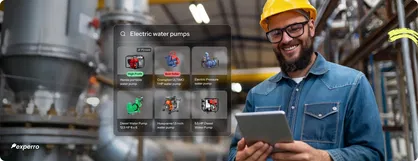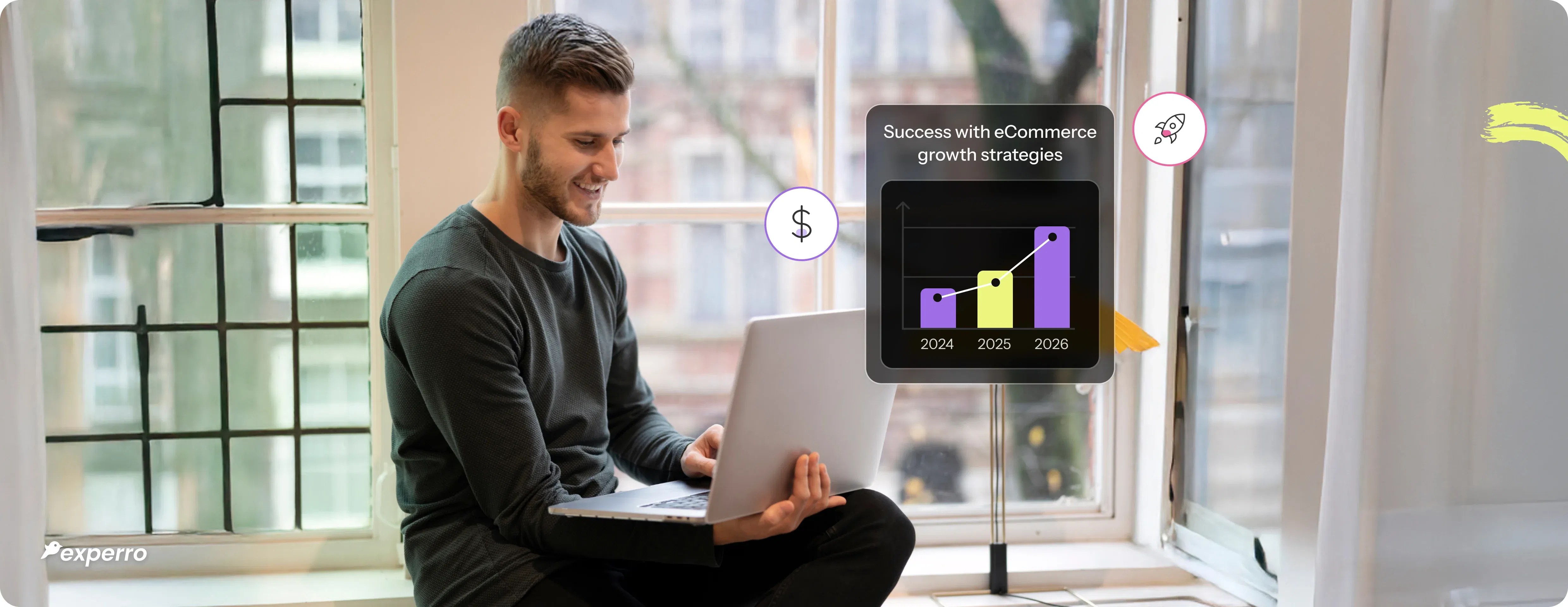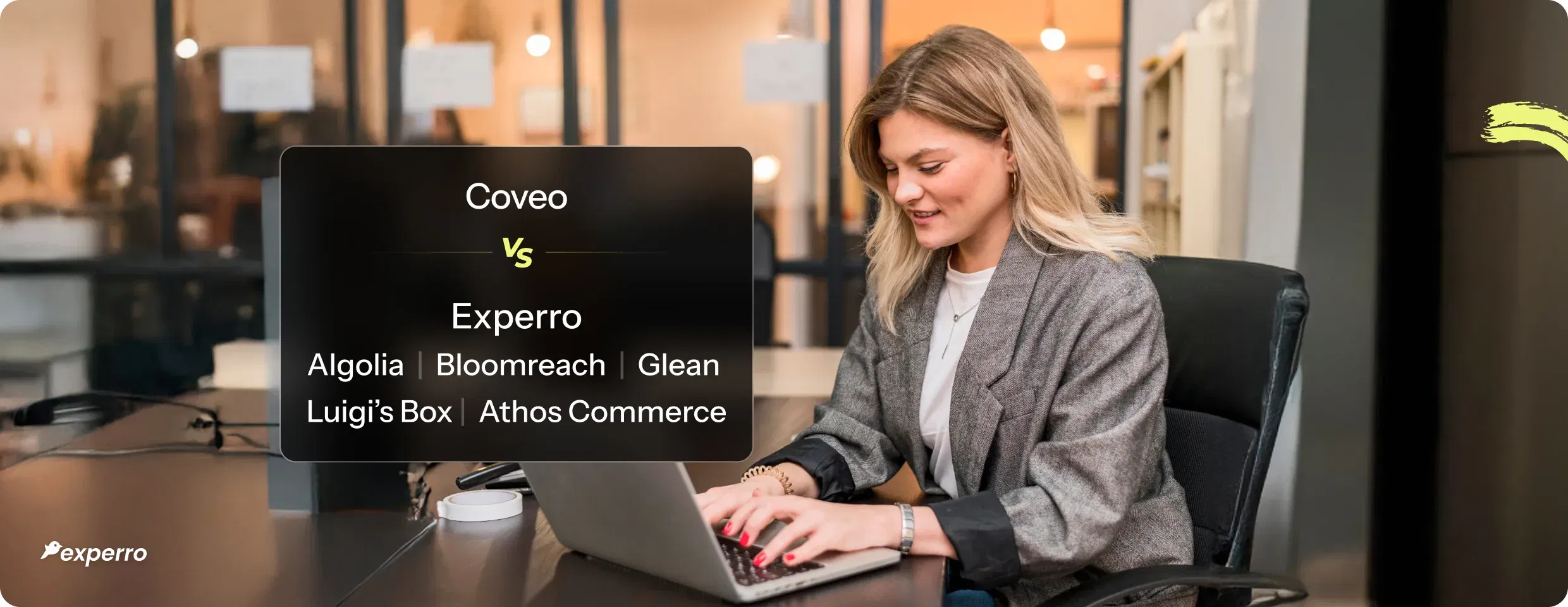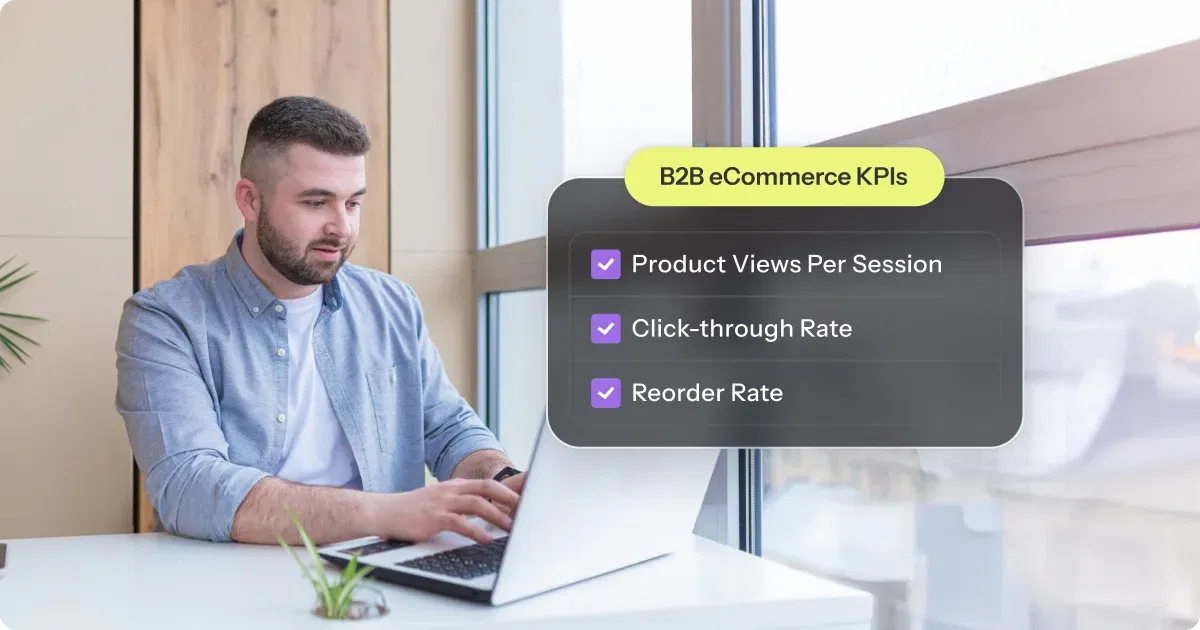core insights box
- Understanding the B2B buying process helps you engage business buyers early and deliver the right message at the right time.
- A clear buying journey reduces friction, aligns internal teams, and shortens the sales cycle.
- Knowing your stakeholders and their needs leads to stronger relationships and higher conversion rates.
- Experro empowers B2B businesses with AI-driven personalization, seamless discovery, and smart merchandising that influence decisions across the funnel.
Ever feel like closing a B2B deal takes forever?
In B2B, you’re not just selling; you’re helping companies move forward.
The B2B buying process is more marathon than sprint. But if you understand how businesses actually buy, you’ll unlock the key to faster deal cycles, stronger relationships, and sustainable growth.
Let’s break down the journey from the first moment a company recognizes a need to the final decision and beyond, and see how you can turn complexity into opportunity.
But first...
What Is the B2B Buying Process?
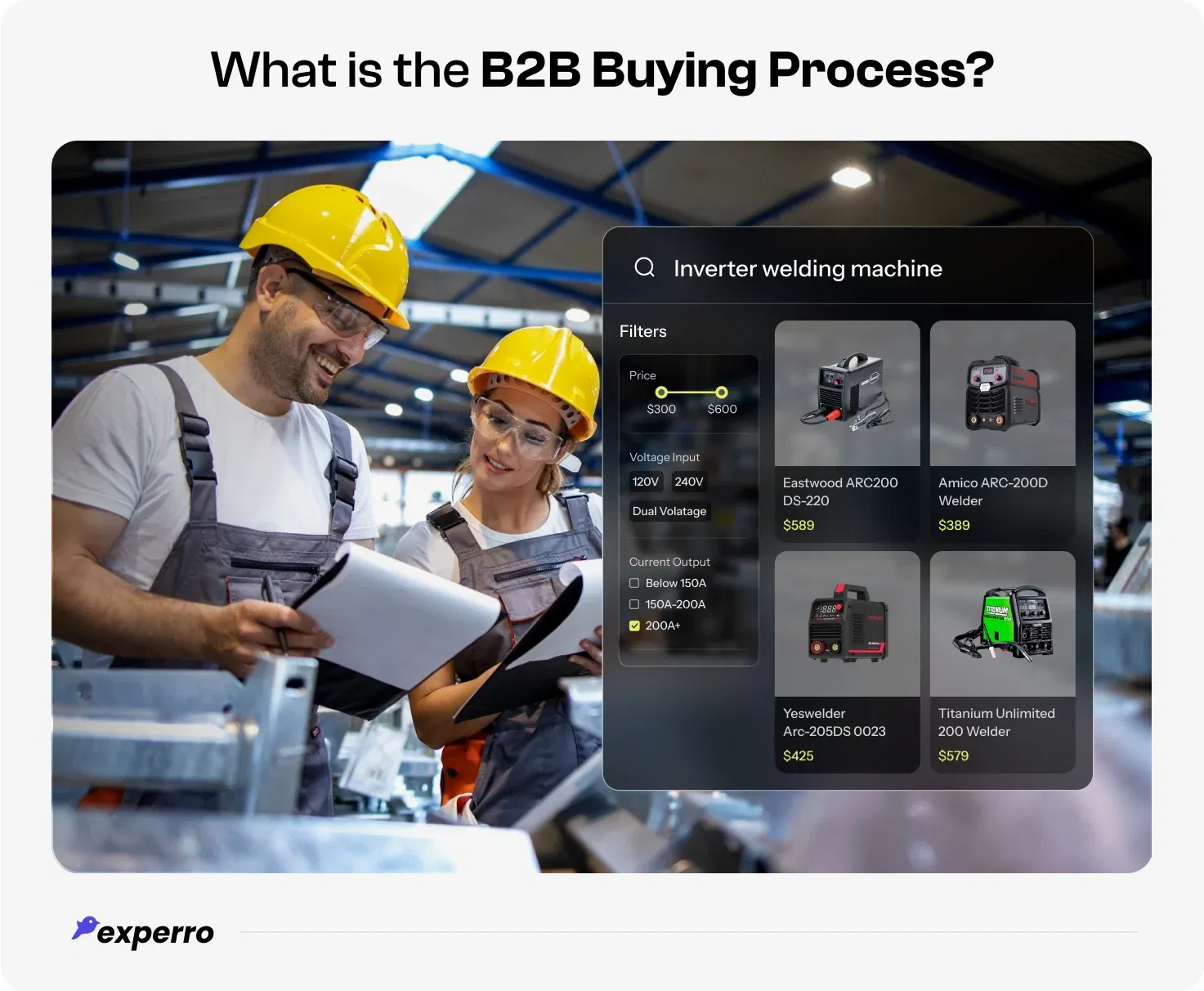
The business to business buying process is a structured journey that a business follows to identify needs, evaluate options, and make informed purchase decisions.
Unlike impulsive B2C purchases, B2B purchasing is logical, research-heavy, and usually involves more than one decision-maker.
From identifying a problem to onboarding a solution, the steps in B2B buying process are meant to minimize risk and maximize ROI. Each stage brings its own set of considerations, which shape the final B2B purchase process.
As shown in the B2B buyer journey statistics, 70% of B2B marketers say understanding the customer journey is essential for effective content marketing, reinforcing the strategic value of buyer journey insights.
Next, let’s break down how this process compares to what happens in B2C buying.
Key Differences Between B2B & B2C Buying
The difference between B2B and B2C buying process lies in the complexity, length, and number of people involved in the decision.
While consumers buy for themselves, B2B customers buy on behalf of organizations, making the stakes much higher.
Let’s check out the table below:
| Aspect | B2B Buying Process | B2C Buying Process |
|---|---|---|
| Decision Involvement | Involves multiple stakeholders across departments | Typically made by an individual or small group |
| Buying Motivation | Driven by business goals such as ROI, efficiency, or compliance | Driven by personal needs, desires, or lifestyle preferences |
| Sales Cycle | Longer, structured, and involves formal approval processes | Short, impulsive, and emotionally influenced |
| Research Depth | Thorough evaluation of product specs, case studies, and vendor credibility | Basic comparison of features, price, and reviews |
| Relationship Building | Focuses on building long-term partnerships and ongoing service agreements | Centered around brand experience or one-time purchase satisfaction |
| Content Requirement | B2B buyer needs detailed content like whitepapers, demos, and ROI-focused materials | Responds better to storytelling, visuals, and benefits-led messaging |
| Pricing and Negotiation | Custom pricing, flexible contracts, and volume-based discounts | Fixed pricing, with seasonal offers or coupons |
| Post-Purchase Support | Ongoing support, onboarding, and integration assistance critical | Minimal support expected; typically limited to basic customer service |
Now that we have learned about the key differences between the business-to-business and business-to-consumer buying, let’s jump into the areas that influence B2B buying decision process.
Discover Experro’s Capabilities for Smarter B2B Buying Journeys!
What Are the Key Factors That Influence B2B Buying Decisions?
Understanding what factors affect the B2B buying process is essential for aligning your strategy with buyer needs.
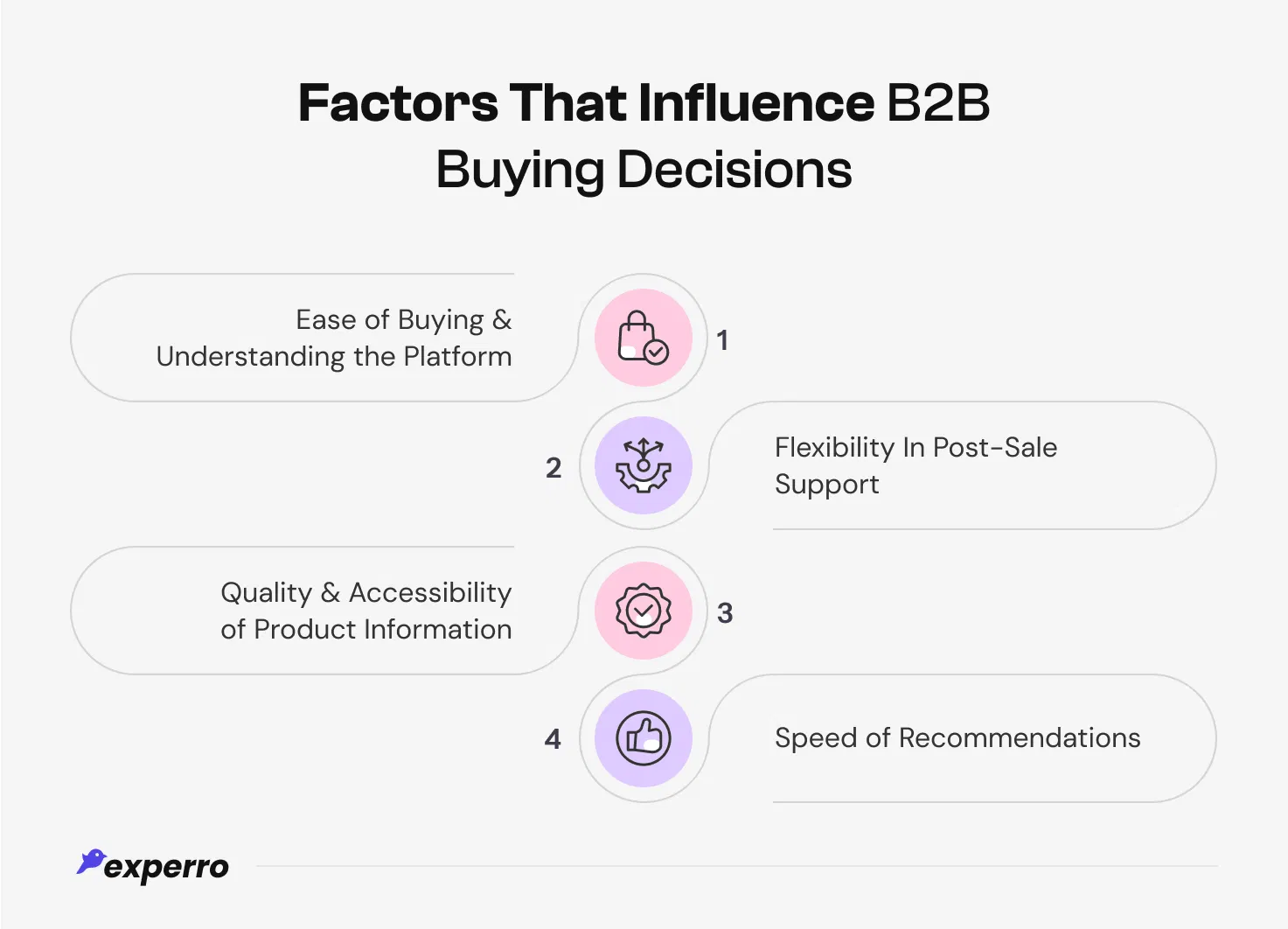
These B2B buying process considerations shape whether your solution makes the shortlist or is left behind.
1. Ease of Buying & Understanding the Platform
One of the biggest barriers in the B2B purchasing process is integration. If your solution doesn’t play well with their current tech stack, you as a business will face resistance.
Buyers prefer tools that enhance their ecosystem rather than disrupt it. Seamless compatibility can often be the deciding factor in the B2B buying decision process.
2. Flexibility In Post-Sale Support
Buyers expect flexible options like subscription models, usage-based pricing, or custom quotes. The same goes for support.
Excellent post-sale service isn't just a bonus; it’s a core expectation in the B2B buying journey. Demonstrating your ability to provide long-term value can turn a one-time deal into a lasting relationship.
3. Quality and Accessibility of Product Information
When product specs, comparisons, or pricing are hard to find, buyers turn to competitors. The B2B buying process thrives on clear, searchable, and detailed information.
Make it easy for buyers to self-educate, especially during the market research phase of the industrial buying process.
4. Speed of Recommendations
B2B buyers expect quick, data backed guidance during their evaluation. If your platform can surface relevant suggestions, alternatives, or add-ons in real time, it can make the B2B buying process faster and accelerate decision making.
The ability to recommend the right solution at the right moment not only builds confidence but also shortens the buying cycle.
The emerging use cases of AI for B2B eCommerce make it easier for brands to align with these buying signals and guide buyers more confidently.
These are the factors that can impact B2B buying decisions. Now, let’s look at why understanding the B2B buying process itself is so important and how is it beneficial.
Why Understanding the B2B Buying Process Matters?
For entrepreneurs, understanding the B2B purchase process is the first step to making smarter business decisions.
When you decode the stages of buying process in B2B market, you can identify exactly when and how to influence decisions. It helps you fine-tune your outreach, refine product positioning, and drive more meaningful interactions with potential clients.
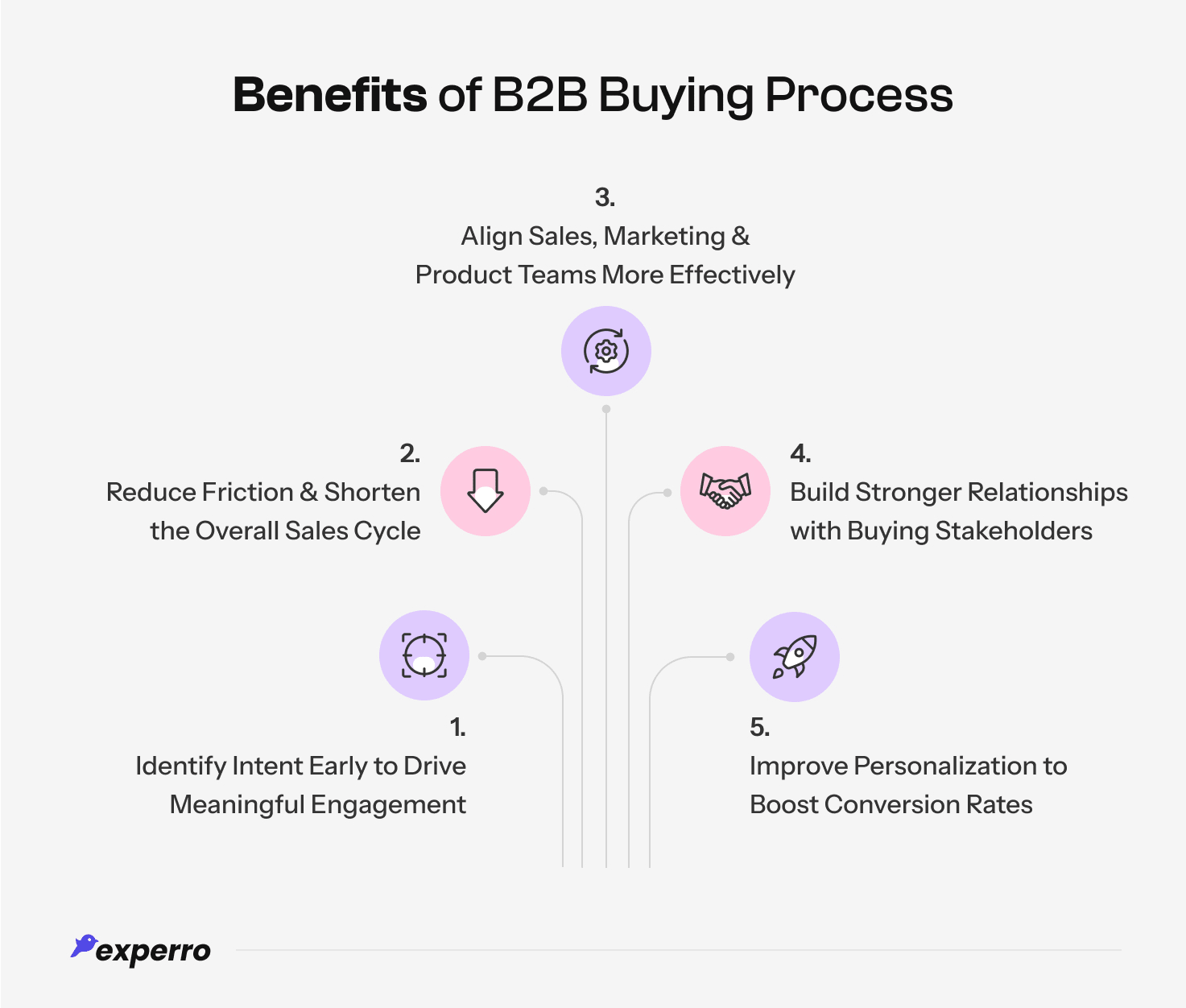
Let’s run through the points below to know the importance of B2B buying process in detail:
1. Identify Intent Early to Drive Meaningful Engagement
Knowing where buyers are in the B2B buying cycle helps you craft the right message at the right time. Behavioral data, search activity, and intent signals give you a clear view into your buyer’s mindset, allowing more targeted, timely outreach.
This early visibility lets you engage with buyers when their interest is high, but vendor options are still open. As a result, your brand becomes part of their consideration set from the very beginning.
2. Reduce Friction and Shorten the Overall Sales Cycle
An optimized B2B buying process removes roadblocks. By proactively addressing common objections or technical questions, you reduce delays and guide buyers to a decision faster.
Every friction point you remove speeds up decision-making and improves the buyer experience. Over time, this leads to a more efficient sales pipeline and better forecasting accuracy.
3. Align Sales, Marketing, and Product Teams More Effectively
A shared understanding of the B2B customer journey ensures internal alignment. Marketing creates the right content, sales focuses on high-intent leads, and product teams build features that buyers actually need.
When sales and marketing departments work toward a unified buyer strategy, the handoffs are smoother and customer engagement is more consistent. This alignment results in fewer missed opportunities and better ROI across the board.
4. Build Stronger Relationships with Buying Stakeholders
Modern B2B companies don’t just sell products, they build partnerships. Personalized experiences, consultative selling, and trust-building all depend on understanding who the stakeholders are and what matters to them.
These deeper relationships reduce price sensitivity and increase long-term customer value. It also leads to more referrals and advocacy within the B2B buying group.
5. Improve Personalization to Boost Conversion Rates
B2B eCommerce personalization is a growth lever. When content and offers match buyer needs, engagement and conversion rates climb.
By delivering tailored recommendations, pricing, and support, you create relevance that drives action. This targeted approach reflects the best of B2B eCommerce best practices, driving faster decisions and better satisfaction.
Dive into the key B2B eCommerce statistics to further understand your B2B buyers.
What Are the Stages of the B2B Buying Process?
Each business decision unfolds through distinct B2B buying process stages. Recognizing where your buyer is in the journey allows you to tailor your messaging, content, and touchpoints accordingly.
From awareness to onboarding, every stage offers a new opportunity to create value and differentiate your brand.
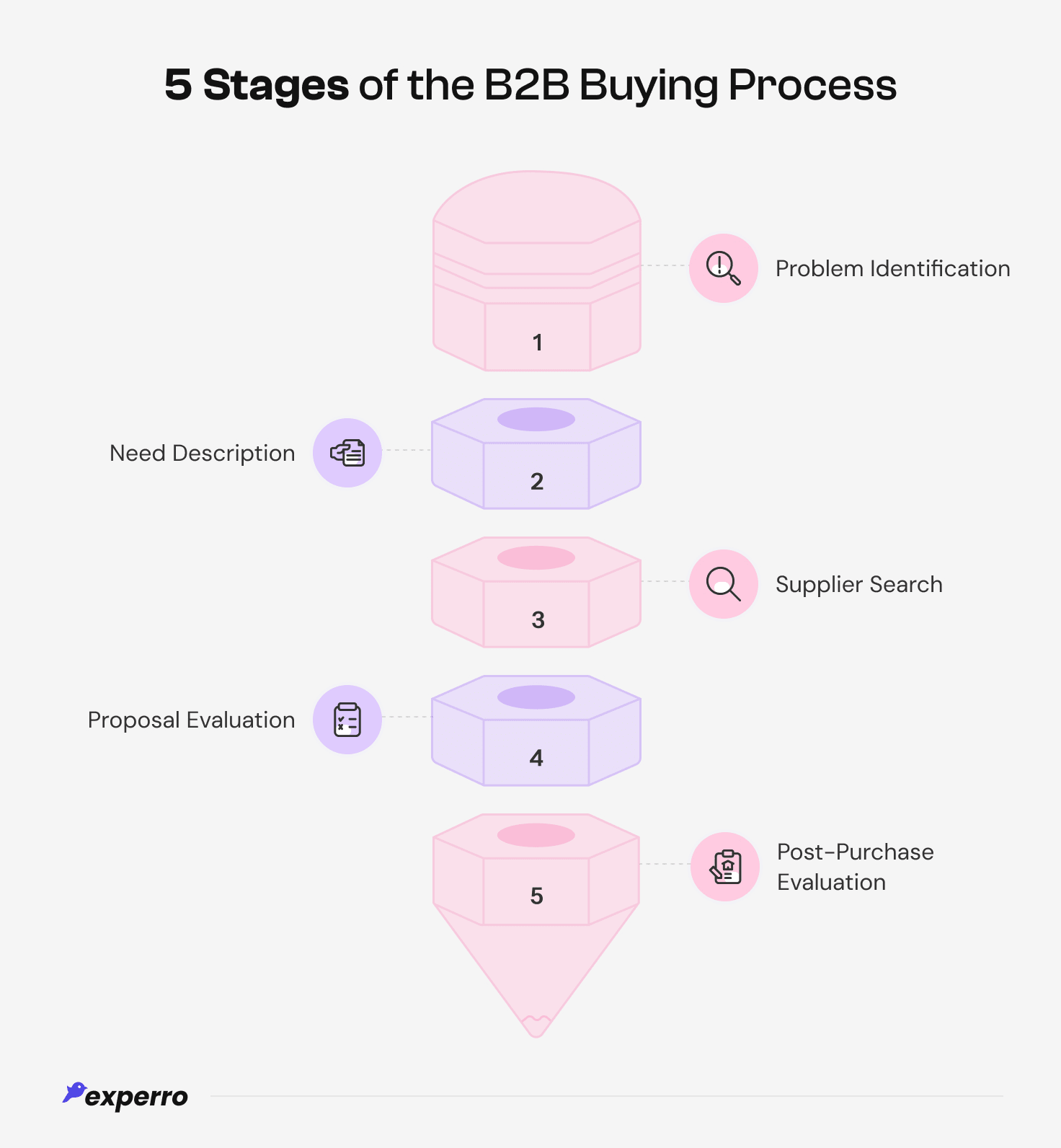
1. Buyer Identifies the Problem
The B2B customer becomes aware of a challenge or inefficiency affecting his/her business operations or revenue. Whether it’s outdated tools or a market shift, this stage kicks off the need for change.
This is your chance as a seller to empathize with the problem and earn early trust. Educational resources, blog posts, or webinars work well to establish credibility here.
2. Buyer’s Need Aligning With Seller’s Product Description
The team defines what the ideal solution should look like. They list features, budget expectations, technical requirements, and performance goals. This is where detailed, keyword-rich B2B product search content can attract attention.
Your messaging should align with buyer expectations and clarify how your offering meets both functional and strategic needs. Helping potential customers shape their requirement list gives you an edge later in the process.
3. Supplier Search
Buyers actively look for vendors, often using B2B search engines, directories, or B2B marketplaces. First impressions matter. Ensure your brand shows up with informative, relevant content that supports search and discovery in B2B.
Since buyers are comparing multiple vendors, strong SEO, reviews, and case studies can help your brand surface. This is your chance to enter the conversation before competitors do.
4. Proposal Evaluation
Shortlisted vendors are assessed through demos, case studies, and pricing comparisons. Teams weigh trade-offs like ROI, integration, and support. This phase is critical in winning the B2B purchasing decision.
Your sales and technical teams should be ready to respond with customized solutions that address the specific pain points identified earlier. A compelling business case at this stage can often tip the balance in your favor.
5. Post-Purchase Evaluation
The solution is implemented and evaluated for performance. Support, onboarding, and training all play a role in buyer satisfaction. If expectations are met, you move from vendor to partner in the B2B industry.
Positive experiences lead to stronger lifetime value and organic referrals. This stage also feeds back into the buyer’s next B2B purchase journey, so it’s crucial not to let the relationship stagnate.
After learning about the stages, let’s jump into the factors that make the buying process difficult for businesses.
Enable efficient, data-driven B2B buying with Experro!
What Makes the Buying Process Difficult for Businesses?
Even with a clear process, the B2B buyer journey isn’t always smooth. These B2B eCommerce challenges often prevent even the best products from making it through the funnel.

Let’s look at some roadblocks that hinder progress:
1. Information Overload Across Digital Channels
Buyers are overwhelmed by product information that lacks clarity or relevance. Without helpful, stage-specific content, they may delay decisions or disengage entirely. The result is decision paralysis and unnecessary sales delays.
A well-structured headless CMS can ease this overwhelm and guide buyers forward.
2. Difficulty in Accessing Relevant Product Information
Incomplete product details, unclear specs, or poorly written descriptions often leave buyers uncertain about their choices. The absence of accurate and easy-to-find information creates friction, pushing them to competitors for clarity.
The result is stalled evaluations and missed opportunities. A well-organized product catalog with detailed, structured, and searchable information helps buyers move forward with confidence.
3. Poor Personalization in Buying Experience
Zero search results, generic recommendations, and irrelevant product content make the buying journey feel disconnected. Instead of guiding buyers to the right solution, these gaps force them to spend more time searching. The result is frustration and a higher chance of drop offs.
Intelligent personalization that adapts to buyer behavior creates a seamless journey and accelerates decision-making.
4. Limited Payment Options
Rigid billing structures are a common friction point. Offering flexible, modern payment solutions can differentiate your brand in the eyes of B2B buyers.
Net terms, milestone payments, or volume-based pricing offer the flexibility that large buyers demand. This adaptability builds trust and removes one more barrier to closing.
5. Lack of Integration with Existing Tech Stack
No business wants a siloed solution. Poor compatibility means added cost and disruption. That’s why deep integration support is key to success and a defining factor in adopting the B2B eCommerce trends.
Offering APIs, plug-and-play integrations, or implementation support makes your solution more attractive. It also shortens time-to-value, a major factor in final approval.
After learning about the hurdles businesses face while making the buying process seamless, let’s take a look at how Experro can help enhance your B2B eCommerce strategy and follow every stage of the buyer journey to ensure a smooth process.
Learning about the difficulties isn’t enough, so now, let’s dive into how Experro can help you avoid the hurdles and achieve B2B buying process optimization.
Give your B2B buyers the experience they expect—Powered by Experro!
Optimizing Every Stage of the B2B Buying Process with Experro!

Experro for B2B eCommerce brings speed, personalization, and intelligence into your B2B buying process. The platform's Gen AI-powered search and discovery features ensure that buyers find what they need faster.
With headless storefront capabilities, seamless integrations, and robust B2B buyer journey, Experro supports every stage of the B2B purchasing process.
From tracking buyer behavior to delivering real-time AI recommendations, we help businesses personalize experiences across channels.
With support for varied pricing models, onboarding, and multi-site experiences, Experro enables B2B sellers to simplify complex B2B buying behavior. It’s not just a platform; it’s a catalyst for growth in the future of B2B eCommerce.
Conclusion
The B2B buying process may be complex, but with the right strategy, tools, and content, you can turn it into a competitive advantage.
Whether you're selling a service, product, or solution, understanding how businesses buy is the first step toward sustainable success.
Schedule a call with our experts for a tailored walkthrough of how Experro can help you streamline your B2B growth.
FAQs
What are the three types of B2B buyers?
The three types of B2B buyers include:
- Users (who use the product)
- Influencers (who affect buying decisions)
- Deciders (who authorize the purchase).
How many stages are in the B2B buying process?
There are six B2B buying process steps:
- problem identification
- need description
- supplier search
- proposal evaluation
- post-purchase evaluation.
What is an RFP in the B2B buying process?
An RFP (Request for Proposal) is a formal document sent by buyers to invite vendors to propose solutions, pricing, and timelines for a defined business need.
How long does the B2B buying process take?
It varies based on complexity, but the B2B buying cycle can last from a few weeks to several months, depending on internal approvals and solution fit.
How can Experro improve the B2B buying experience?
Experro accelerates the B2B purchasing decision with AI-driven search, personalized experiences, flexible pricing tools, and seamless integrations for faster conversions.
What factors influence B2B buying decisions?
The factors that influence B2B buying decisions include:
- Ease of buying & understanding the platform
- Flexibility in post-sale support
- Quality and accessibility of product information
- Speed of recommendations
Pallavi Dadhich
Content Writer @ ExperroPallavi is an ambitious author recognized for her expertise in crafting compelling content across various domains. Beyond her professional pursuits, Pallavi is deeply passionate about continuous learning, often immersing herself in the latest industry trends. When not weaving words, she dedicates her time to mastering graphic design.
What's Inside
- What Is the B2B Buying Process?
- Key Differences Between B2B & B2C Buying
- What Are the Key Factors That Influence B2B Buying Decisions?
- Why Understanding the B2B Buying Process Matters?
- What Are the Stages of the B2B Buying Process?
- What Makes the Buying Process Difficult for Businesses?
- Optimizing Every Stage of the B2B Buying Process with Experro!
- Conclusion
Subscribe to Our Newsletters
Get the latest insights delivered straight to your inbox.
